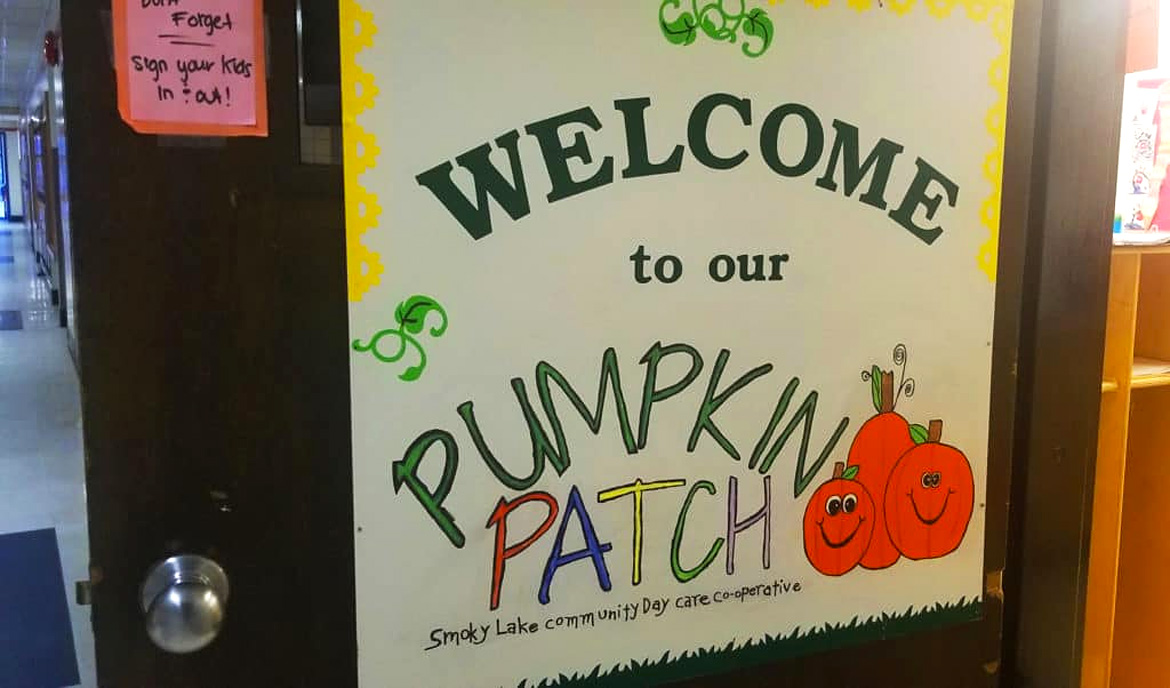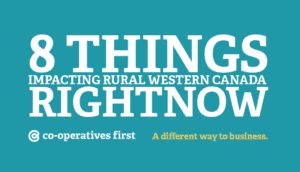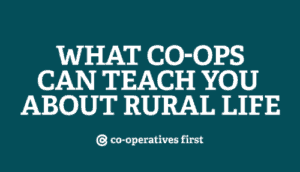People are resourceful in small-town Alberta. In Smoky Lake — population 960 — there had never been a childcare facility, and parents always had to cobble together childcare plans.
They made it work, but last year a group from the community decided there must be a better way.
In May 2018, parents packed a local church to hear representatives from Co-operatives First and the Government of Alberta explain how a childcare co-operative could work. They liked what they heard, and assembled a steering committee to start building the business. In October 2018 the Smoky Lake Community Daycare Co-operative opened its doors.
Lauren Melnyk is a local parent who helped spearhead the chilcare co-op; she’s now the childcare centre’s director. Known as The Pumpkin Patch — for the town’s status as “Pumpkin Capital of Alberta” — it consists of two classrooms in the local school, and can host up to 42 children. The rooms are packed with toys, games, and dress-up clothes donated by the community, and school trophies still line glass cases on the wall.
This local, licensed childcare facility gives parents a flexibility they didn’t have before.
“We have so many farm families that had to just figure [childcare] out themselves,” Melnyk said. “A lot of moms kid-swapped throughout the week, they’d all the take kids one day a week, and then on their day off they got all their stuff done… People just babysat for each other, free of charge – you take my kid I’ll take your kid.”
An important – but underused – model
The co-operative model is a natural fit for rural daycares. Run on a non-profit basis by boards made up (mostly) of parents, childcare co-ops can be more flexible and respond more quickly to the needs of the children.
There are hundreds of childcare co-ops in Canada, and while they have a long history in some parts of the country, they are absent in others. Saskatchewan has over 100 pre-school and childcare co-operatives – the second-highest in Canada. Many of these were created in the 1970s and 1980s when provincial policy prioritized non-profit childcare co-ops. The trend can still be seen today.
Just next door in Alberta, though, there were some co-operative pre-schools but no childcare co-operatives – until the Pumpkin Patch came along.

Bringing the community together
So how did Smoky Lake get a great childcare centre up and running in such a short amount of time? A lot of dedication, hard work, and community support.
Immediately following the May community meeting a group of parents (and some others) formed a steering committee and got to work. They met weekly for the next few months to talk about everything from the co-op’s structure to location to fundraising.
These weekly check-ins helped the group delegate tasks and keep each other accountable. They decided to outsource the co-op’s incorporation and bylaw creation to a lawyer, but otherwise did the work themselves.
“Looking back, it’s funny because my husband would joke ‘do I get my wife back yet?’ and I’d be like ‘Nope! Not quite’,” Melnyk said. “I did not realize how much work it was going to be.”
Over the summer the co-op held a few fun community fundraisers, including a Canada Day BBQ and a mobile escape room event. They also sent out a list of items that the daycare needed, and the community responded with donations.
Most of the toys, games, and furniture that fill the centre were donated by community members and saved the co-op precious start-up dollars. The Kinsmen Club donated money for operations, and plans to give more for indoor play equipment. The Kinettes gave money for a six-seat stroller. A local dental office even donated a year’s worth of gloves for staff to use when changing diapers.
Community partners soon took notice of the project. The Town and the County both contributed funds and sent representatives to sit on the board. The advantage of this wasn’t just the financial support. If the board had questions about something that pertained to one of the municipalities, someone at the table immediately had an answer.
The school became another vital partner.
While they were hunting for a suitable, affordable location, the school superintendent contacted the co-op to say they could provide room in the school, rent-free.
The relationship with the school is win-win-win…win. The daycare gets a space at no cost. The school can say that it is being fully utilized (an important factor, given the town is pushing for a new school). Plus, the kids in daycare become familiar and comfortable with the building before they start kindergarten.
For parents with school-age kids, they can drop off kids at one place, and have extended hours to do so. The childcare co-op provides before and after-school care, with kids just going from one part of the building to another.
Working through challenges together
The beauty of creating a childcare co-operative is the flexibility to do what works best for parents.
Some childcare co-ops only allow full-time enrollment or require parents to share full-time spots for ease of scheduling and billing. The Smoky Lake group decided this didn’t work for them and offers full-time, part-time, and drop-in options.
Determining fees was also difficult, but working them out has given the group a better understanding of the costs of childcare.
“We debated our fees for months,” Melnyk said. “It was so hard, mostly because you can’t pay staff if you’re not charging people enough — the ratios for childcare in Alberta make it difficult to make money, because you have to have so many staff on. This is why childcare is so expensive, you don’t realize it when you’re an outsider, you just think ‘This sucks, I don’t want to pay this much!’. But when you look at it from the inside and how you have to staff it accordingly, you have to have your fees higher than you want.”
One expected challenge never materialized. At first, people worried that a parent-run facility would have trouble getting things done – that there would be “too many cooks in the kitchen.” In fact, Melnyk said, the board has been great at leading the project and making decisions.
“The people there are such a diverse group, they all have different opinions to bring to the table and it just works out. …We have working moms, we have people who work for the government so they know that side of things, we have different people with different ways of parenting or viewing how a daycare should be run, whether they’re business-minded or personally invested. When we get all sides brought in it’s like ‘okay, now we can make a rational decision.’”
Given the success of The Pumpkin Patch, people from nearby communities have started approaching Melnyk and others to find out how they did it. She encourages them to use the co-op model, and says it’s a steep learning curve, but a great way to get the community involved.
“All these really cool things are coming about and I think it’s because it’s co-operative,” she said. “It wouldn’t have happened otherwise.”
Thinking about starting a childcare co-operative? Visit our childcare resource page to get started!

 Written by
Written by 



